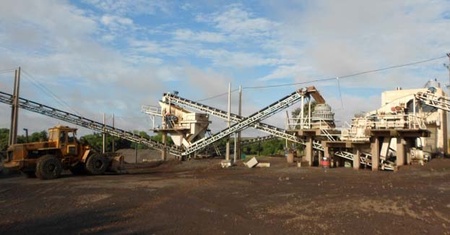パラグアイは、南米中部に位置しており、アスンシオン国際空港で売られているTシャツには「CORAZON DE AMERICA(アメリカ(南米)の心臓)」と描かれている。内陸の国で、ブラジルとアルゼンチンという大国の狭間で独立後も様々な試練を乗り越えながら生存してきた国である。ここ10年前ぐらいまでは、南米ではボリビアに次いでもっとも平均所得が低く、格差も大きい国だった。詳細は各サイトで把握することが出来るが1、面積では日本より多少広い40万km2で、人口は650万人、国民総生産は円換算にすると2兆2千億円相当で、一人当たりの年間平均所得は3,700ドル(34万円)である。アスンシオン首都圏には250万人が集中しており、首都を含むこの国の東部地域に人も生産も富も集中している。教育や医療の普及に向けての課題は多く、都市部と農村部との格差は大きい。しかし、穀物の国際価格上昇等によって経済は成長軌道にのり、国内の消費市場も拡大し、近年外資系企業の進出も目立っている。

イグアスの日系農協が経営している製粉工場であり、数種類の製粉を生産している。すぐ近くに大豆等のサイロもあり、一部は日本にも輸出している。イグアスだけでも、年間5万トンの大豆と約2万トンの小麦を生産、4つの移住地で大豆が15万トン、小麦が7万トンに及ぶという。
そしてこの国にも日本人移住者の歴史がある。1936年にラ・コルメナ移住地へ入植が行われたが、現在の日系人のほとんどは戦後移民である2。ボリビア中東部、ブラジル南西部や北東部、アルゼンチン北東部等への移住地入植と同様に、原野の開墾からはじまり、ゼロから生活基盤とインフラ(学校、道路、病院、農協等)を整備し、街づくりから地域開発をすすめた。日本政府(主にJICA国際協力機構)や様々な民間団体の支援があったとはいえ、想像を絶する努力と忍耐で、多くの功績を残している。しかし、移住地での主要農作物である大豆等穀物の価格が高騰するまでは、どの農業従事者世帯もかなり厳しい経営を余儀なくされてきた。現在は、農協だけではなく日本人会も地域経済との共存とその発展のために様々な取り組みをしており、事業の多角化や開発事業も積極的に展開している。
しかし、パラグアイの移住地は、他国の日系社会と同様に、様々な課題に直面している。一世の世代から二世へのバトンタッチ(一世の高齢化と、二世の現地化と都市化)、グローバル経済対応の経営手法(大豆や胡麻は輸出の対象になっており、今後は世界経済の動向が移住地農業に更に影響を与えると思われる)、地元社会との格差是正とバランスある地域開発(一般的に日本人移住者の方が裕福で、地元の一般住民との経済格差がある。政治的な思惑もあって「土地なし先住民団体」が、格差是正を求め移住地の一部を不法占拠する事件を起こした3)、農家の後継者問題(二世の一部は親の事業を継続しているが、学歴が高くなるにつれ都市部で職に就く傾向にあり、日本で職を得る者も多数いる)、日系団体の運営方法の変化(二世代目になると会費制を維持するのが難しく、事業単位で資金を確保する必要がでてくる)等々である。
一方、パラグアイの移住地には、他国の日系社会にはあまり見られない課題も発生している。パラグアイの地理的・社会労働的要素ゆえに、移住者たちは、移住地内にほぼ全ての組織を完備し、自立した形でコミュニティを発展・形成してきた。そのため移住地には、支援を活用しながら自ら建設・運営している学校、医療施設、文化・スポーツ施設などがあり、日本人会や農協が自治体の役割を担ってきたといっても過言ではない(ボリビアの日本人移住地も同様である)。こうした状況は、日系社会の外からみるとかなり閉鎖的にうつるが、尊敬の対象でありながらも嫉妬と妬みの対象になることも少なくなく、逆差別現象が発生してしまう恐れがある。
こうした課題に対応するためにも、今回、パラグアイ日本人会連合会とJICAパラグアイ事務所は、協同で「国際(ラ米)日系セミナー」を企画した。約900人の日系人が住んでいるイグアス移住地(アスンシオンから320キロ、日系人人口はその地区の1割弱)で開催され、パラグアイ日系社会の指導者たちをはじめ、ブラジル、アルゼンチン、ボリビア、ペルー、ウルグアイ、そしてドミニカ共和国の日系代表者が参加した。南米の日系社会の今後の展望というのが題目であり、筆者はメインスピーカーの一人として日本から派遣され、人材育成の観点からプレゼンを行った。
私は、出身国のアルゼンチンだけでなく、歴史が長く都市型日系社会(当初は農業にも従事)の実績があるペルー、多様性の高いブラジルの一部、小規模であるウルグアイやチリの日系社会などを訪れたことがある。その時に得た各国の日系社会に対する知見、15年近くにわたってJICA日系研修員の受け入れ事業に関わって得た交流(年間130人程度で、分野も年齢も様々で日本政府が実施している研修制度)、そして南米日系で稼ぎ労働者の受入と対応、日系留学生等と関わってきた経験等をふまえて、人材育成の重要性について話をした。出席者がどこまでその重要性を認識し、今後どのような対策を実施するかが、注目される(後継者がいないとぼやいているだけだったり、人材育成をJICA任せにするだけでは、やはり限界がある)。
私は、移住地等に存在するローカル人材と都市部や海外にいるグローバル人材の連携が必要だと考えており、日系社会の中にもそうした人材は当然存在する。しかし、不安材料が多い世界経済の中、これまで以上に複雑な課題に対応し、将来の展望を少しでも見極めるには、日系人や日本というものだけに執着せず、非日系人や、人種や国籍にこだわらず人材ネットワークを形成することが重要である。
パラグアイの移住地では、昔から地元の学校には二世を含め日系人の方が多く、社会生活も日系社会内で完結してきた経緯がある。しかし、地域社会も発展し、非日系の人口も増えた今、利害関係も複雑になってくる。事業拡大や輸出等に取り組もうとすると、グローバル的な対応も必要になり、ローカル人材でも高度な知識や専門性、広範囲な人脈が求められ、一部の指導者には多様な交渉力と政治力が要求される。これは、単なる大学教育や海外留学で磨けるものではない。分科会でも取り上げられたが、一人の人間としてのリーダーシップだけではなく、時には団体または集団としてのリーダー的要素(イニシアチブ)や、地域社会との調和と調整能力が必要になる。
ペルーやブラジルの経験と試みを見ても、いくら日系人人口が多いといっても、全体の1%にも満たない存在である。各代表団から様々な事例が紹介され、パラグアイの日系指導者にとっても参考に出来るものがあったに違いない。
日系社会はどこでもマイノリティーだが、その移住先で功績が高く評価されるにつれ、時には嫉妬や誤解、明確なアピール不足もあって複雑な緊張関係を招いてしまう。逆に日本では、マイノリティー(我々外国人はその分類に入る)を弱者、社会の底辺にいると位置づける傾向もあり、その多様性(最近は、ダイバーシティーというようだが)や文化的特徴と付加価値をどのように自分の社会のために活用したら良いのかという発想が、未だに乏しい。ようやく近年切羽づまった状況を反映してか、日本の大学で学位を取っている外国人留学生を採用・登用するようになり、グローバル企業(大手とは限らず、中小・小規模であっても精鋭の人材を雇用する企業を含む)は、かなり積極的にこうした人材を確保しようとしている。一部の企業はかなり柔軟な契約方式で採用しているが、まだそうしたダイバーシティーマネジメントのノウハウが十分とはいえない側面もあるようだ。
海外にいる日系人は、生存のため日本人的な素質と地元で養った価値観をフルに活用し、多様性の中で自分の異なった部分を適度にアピールし、実績を残してきた。多様性の運営では、既に多くのノウハウを得ているが、すべての日系人がそうした要素の持ち主ではない。パラグアイの日系社会等を見る限り、素晴らしい人材は存在するとはいえ、ローカル人材(団体や農協の指導者)のグローバル人材との連携や信頼関係、勉強会という交流はまだ少ないように感じた。様々なしがらみもあるようだが、移住地の更なる発展は地域社会への統合を深化しなくてはならない。当然、非日系の地元住民や有力者をもっと発展プロセスに参加させ、その恩恵に授かれるようにしなくてはならない(支援の対象だけにしては、ダメである)。このようなことができる技量と社会的・政治的センスのある日系指導者であれば、日本との関係も更に発展し、自立した対等な関係も実現できるに違いない。
実は、他の南米諸国の日系社会でも、農村・都市部を問わずスケールは異なっても、同じような課題を少なからず抱えており、今回の国際セミナーは、こうしたことや横のつながりの必要性を、自覚させた素晴らしい機会であったと言える。
注釈:
1. http://www.jica.go.jp/paraguay/office/others/gaiyou.html パラグアイ共和国概要(JICA)
http://www.mofa.go.jp/mofaj/area/paraguay/index.html パラグアイ、日本外務省サイト
http://www.embapar.jp/subsitio2/paraguay/index.html 駐日パラグアイ大使館サイト
2. http://www.jica.go.jp/paraguay/office/activities/immigrant/02.html JICAパラグアイ事務所
http://rengoukai.org.py/ja/la-sociedad-nikkei/idonde-estamos 移住地の概要
http://www.geocities.jp/meishoparaguay2010/colonia.html イグアス移住地写真
http://rengoukai.org.py/ja/la-sociedad-nikkei/idonde-estamos/colonia-yguazu 連合会サイト
3. http://jbpress.ismedia.jp/articles/-/30950 土地なし集団のイグアス移住地不法占拠事件
© 2013 Alberto J. Matsumoto










